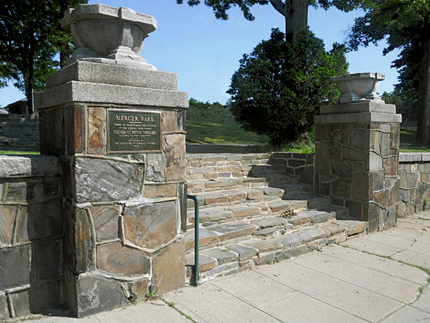



Mercer Park
John F Kennedy Blvd., near West 63rd St.
Map / Directions to Mercer Park
Bergen Neck Fort Historic Sign
Avenue B between 51st and 52nd Streets
Map / Directions to Bergen Neck Fort Historic Sign
Brigadier General Hugh Mercer [1]
Hugh Mercer was born in 1725 in Scotland, where he studied medicine at the University of Aberdeen and became a doctor. He immigrated to Pennsylvania in 1747 and continued to work as a doctor.
Mercer served as an officer during the French and Indian War in the 1750's, rising from the rank of captain to colonel. During the war, he met and became friends with George Washington, who was then in his twenties and also serving as a colonel. [2]
In 1760, Mercer moved to Fredericksburg, Virginia, and continued his medical career by setting up an office and apothecary shop. He maintained his friendship with Washington, whose Virginia home Mount Vernon was located about 40 miles to the northeast. In 1774, Mercer bought property from Washington just outside of Fredericksburg; the property, known as Ferry Farm, had been Washington's home in his youth which Washington had inherited when his father died. [3]
The following year, the Revolutionary War began, and Mercer became the colonel of a group of Virginia militiamen, and then a colonel in the Continental (American) Army. On June 5, 1776, he was made a Brigadier General in the Continental Army. [4]
In early July 1776, Mercer was at Bergen Neck Fort which was located about a half mile southwest of where the park is. The fort's name derived from Bergen Neck, the name for the peninsula which makes up what are now Bayonne and Jersey City. Bergen Neck Fort was abandoned by the American forces several months later on October 5. It was later taken over by Loyalists (Americans who remained Loyal to the British in the war) who renamed it Fort Delancey and occupied it for most of the rest of the war. [5] There is a historic sign on Avenue B between 51st and 52nd Streets marking the location of the Bergen Neck Fort / Fort Delancey. [6]
General Mercer died from wounds suffered at the Battle of Princeton in January 1777. Shortly afterwards, Fort Mercer along the Delaware River was named for him. It was the first of several honors bestowed on General Mercer's memory in New Jersey. In 1838, Mercer County was named in his honor, as was Mercer Airport (now called Trenton-Mercer Airport) in 1929. This park was named for him in 1953. [7]

1. ^ In addition to the sources listed below, some general biographical details about Hugh Mercer in this entry were drawn from:
John T. Goolrick, The Life of General Hugh Mercer (New York and Washington: The Neale Publishing Company, 1906)
Available to be read at the Internet Archive here2. ^ Four letters exchanged by George Washington and Hugh Mercer during the French and Indian War are available to be read at the Founders Online / National Archive website here
3. ^ The apothecary shop run by Hugh Mercer in Fredericksburg is now a museum run by the Washington Heritage Museums. The site of Ferry Farm is also open for tours by the George Washington Foundation.
Four letters exchanged by George Washington and Hugh Mercer regarding the sale of the Ferry Farm property are available to be read at the Founders Online / National Archive website here
4. ^ Journals of the Continental Congress, Volume V (Washington D.C.: Government Printing Office, 1906) Page 420
Available to be read at the Internet Archive here5. ^ “From George Washington to Brigadier General Hugh Mercer, 4 July 1776,” Founders Online, National Archives, last modified October 5, 2016, http://founders.archives.gov/documents/Washington/03-05-02-0141. [Original source: The Papers of George Washington, Revolutionary War Series, vol. 5, 16 June 1776 – 12 August 1776, ed. Philander D. Chase. Charlottesville: University Press of Virginia, 1993, pp. 206–207.]
“To George Washington from Brigadier General Hugh Mercer, 8 July 1776,” Founders Online, National Archives, last modified October 5, 2016, http://founders.archives.gov/documents/Washington/03-05-02-0174. [Original source: The Papers of George Washington, Revolutionary War Series, vol. 5, 16 June 1776 – 12 August 1776, ed. Philander D. Chase. Charlottesville: University Press of Virginia, 1993, pp. 243–244.]
"Extract of a letter from head-quarters at Bergen, Oct. 4," Pennsylvania Journal and Weekly Advertiser, October 9, 1776, reprinted in:
William S. Stryker, editor, Archives of the State of New Jersey, Second Series, Vol. I (Documents Relating to the Revolutionary History of the State of New Jersey) (Trenton: John L. Murphy Publishing Company, 1901) Pages 207 and 208
Available to be read at the Internet Archive hereRoyden Page Whitcomb, First History of Bayonne, New Jersey (Bayonne: R. P. Whitcomb, 1904) Pages 41-51
Available to be read at the Internet Archive here
6. ^ The historic sign reads, "Bergen Neck Fort - Built by Americans, 1776, at the site of Bayonne. Occupied 1777-82 by Loyalist forces, who named it Fort Delancey."
7. ^ For more information and accompanying sources notes about the events mentioned in this paragraph, see the pages linked within the text.